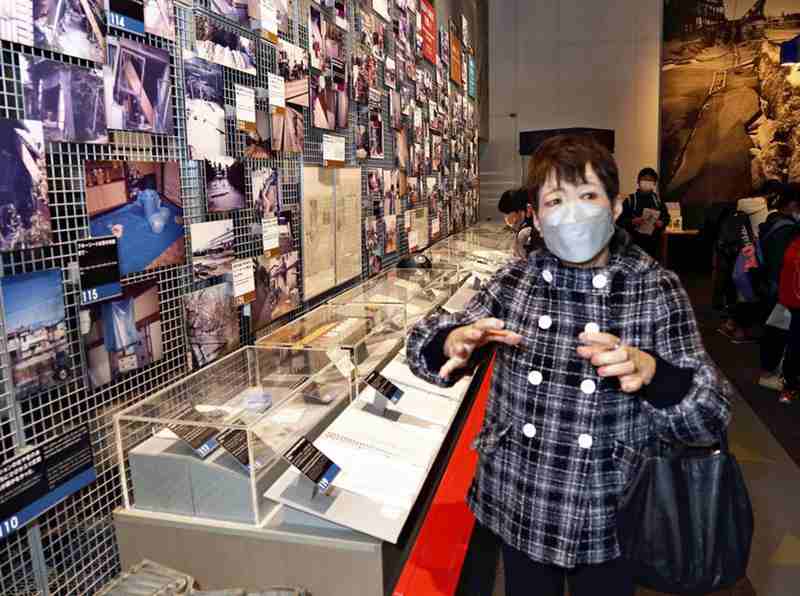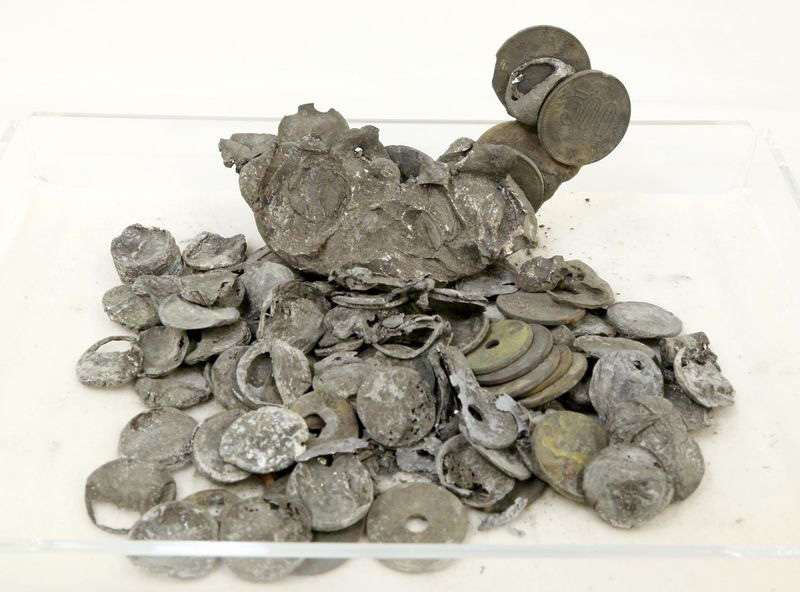
Kayoko Nishiguchi recalls the days in the wake of the disaster, in front of the display of the lump of molten coins at the Great Hanshin-Awaji Earthquake memorial museum in Chuo Ward, Kobe.
13:55 JST, January 17, 2022
KOBE — Monday marked 27 years since the Great Hanshin Earthquake in which 6,434 lives were claimed.
A lump of coins melted together in the fire that broke out following the quake is on display at the Great Hanshin-Awaji Earthquake memorial museum at the Disaster Reduction and Human Renovation Institution in Chuo Ward, Kobe, which passes down memories of the massive quake.
The coins were found by Kayoko Nishiguchi, 72, who is from Nagata Ward, Kobe, in the ruins of the apartment her mother-in-law lived in that was burned down. Visiting the museum just before the 27th anniversary, Nishiguchi said, “I want the younger generation who don’t know about the disaster to take a look at the coins as an item that conveys the horror of the quake and the [ensuing] fires.”

Coins melted by fire that were found in the burned ruins after the quake
The coins were mostly ¥500 and ¥100 coins saved up in a piggy bank by Yui Nishiguchi, the mother of Kayoko’s husband Yoshihisa, who died a few years ago at the age of 65. Nishiguchi donated the lump of coins to the institution in 2001, a year before it opened its museum.
Yui was stuck under the debris of the Hyogo Ward apartment building, which was destroyed in the quake. She was rescued by Yoshihisa and Kayoko, who rushed to the scene, although later she was badly scalded with water that was being heated.
On the other hand, the whereabouts of Yoshihisa’s aunt, who was in her 80s and lived in a different room in the same apartment, were unknown, prompting Kayoko to leave a piece of corrugated cardboard at the burned-down apartment with a message saying, “We are looking for our relative.” The cardboard burned up many times with the remaining heat of the sputtering fire. Every time, she remade it, looking desperately for their aunt. A few days later, she received a message from the Self-Defense Forces saying, “Her bones have been found.”
The bones she received from SDF personnel turned out to be so tiny that she could hardly believe they belonged to a human. Placing the bones in a rice cooker, she walked around the town, which was reduced to fire-ravaged ruins. At a hospital, she saw a body burned pitch-black from a fire. It was a horrible sight she had never experienced before. “We won’t be able to rise up and rebuild our town again, will we?” she wondered, with tears spilling down her cheeks.
Afterward, she went to the ruins of the apartment several times and that was when she found the coins kept by Yui. The tiny box had no trace of its original form, with the coins inside it molten and stuck together in a large lump.
“They looked like lava. When a house continues burning, this is what it turns into,” she thought, feeling the horror of fires in the wake of a quake.
She kept the molten coins in her custody for a while. When she learned later that the institution was calling for people to contribute data and materials related to the quake in preparation for opening the museum, she decided to donate them. “Do as you like,” Yui told Kayoko, giving ready consent.
On her recent visit to the museum, Kayoko saw the coins on display for the first time in four years. Recalling her memory of Yui, who died many years ago at the age of 89, she said, “My mother-in-law would surely be glad they are still on display. There is no telling what sort of disaster could occur and when. I would be happy if the children who see this prepare [for a disaster], no matter how much.”
Related Tags
"Society" POPULAR ARTICLE
-

M4.9 Earthquake Hits Tokyo, Neighboring Prefectures
-

Israeli Tourists Refused Accommodation at Hotel in Japan’s Nagano Pref., Prompting Protest by Israeli Embassy and Probe by Prefecture
-

M7.5 Earthquake Hits Northern Japan; Tsunami Waves Observed in Hokkaido, Aomori and Iwate Prefectures
-

Tsukiji Market Urges Tourists to Avoid Visiting in Year-End
-

High School in Kyoto Says Students Shoplifted during Recent School Trip to Bali, Indonesia
JN ACCESS RANKING
-

Tokyo Economic Security Forum to Hold Inaugural Meeting Amid Tense Global Environment
-

Keidanren Chairman Yoshinobu Tsutsui Visits Kashiwazaki-Kariwa Nuclear Power Plant; Inspects New Emergency Safety System
-

Imports of Rare Earths from China Facing Delays, May Be Caused by Deterioration of Japan-China Relations
-

University of Tokyo Professor Discusses Japanese Economic Security in Interview Ahead of Forum
-

Japan Pulls out of Vietnam Nuclear Project, Complicating Hanoi’s Power Plans

























